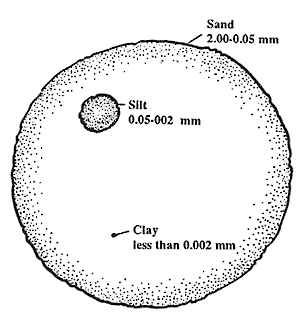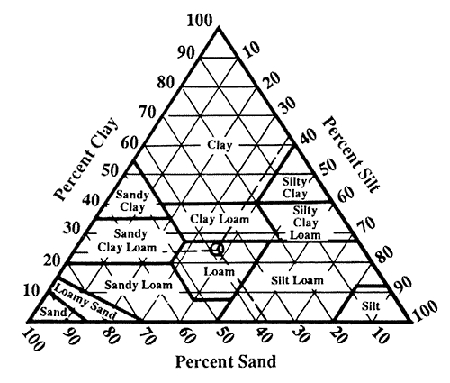Soil
Soil - one of the best by-products of weathering!
A typical soil will consist of the following:
-
Mineral Matter 45%
-
Sand - a byproduct of mechanical weathering. It is pretty much what
is left behind after a chunk of granite has been weathered. Sand is
nothing more than quartz - pure silica. Quartz is very resistant to
chemical weathering but is constantly being broken down to smaller and smaller
pieces by mechanical processes.
-
Silt
-
Clay - Both silt and clay are the byproducts of chemical weathering of
granite. Many types of feldspar release silt and clay when attacked by
acid rain.
-
Organic Matter 5%
-
Water 25%
-
Air 25%

Permission from U of
Nebraska
There are many different types of soils. Soil scientists
classify soils by there relative percents of sand, silt, and clay (see image
below).

Permission from U of
Nebraska
We (in
Southeast Wisconsin) have a rather high silt content. Click
here
to see a soil map of Wisconsin.
The different types of soil result from differences in:
-
Parent minerals (local bedrock or transported material)
-
Climate
-
temperature
-
humidity
-
rainfall
-
vegetation (which can hold the soil as well as provide organic
matter for future soil)
-
animals (which eat the vegetation as well as provide organic matter for future
soil)
-
Slope (good soil is usually not found on steep slopes but
is usually washed to lower, flatter areas)
The vertical profile of soil indicates the composition changes
with depth. These "layers" are called horizons. Typically the
upper layers are richer in organics (which decreases with depth).
However, mineral composition usually increases with depth.
Burrowing animals and root action help "mix" the composition between layers.
The Midwest is considered the "nations bread basket" because
of its rich soil and moderate climate. One contributing factor is
the supply of a wide variety of minerals provided by glacier weathering
and erosion (which formed over Wisconsin several thousand years ago).
Soil should be valued! When it is gone, it takes
several thousand years to re-generate. The famous "Dust
Bowl" in the 1930's (and clear cutting of forests...which leads to
soil run-off) is a reminder that we must treat soil as a valuable natural
resource.
You can bet that soil scientists play an integral part in helping
farmers manage their soil to insure that crops have the proper nutrients as well
as strategies to maintain the soil for future generations.
ŠJim Mihal 2004,
2006 - all rights reserved


